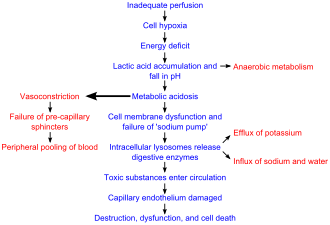Shock (circulatory)

Editor-In-Chief: Prab R Tumpati, MD
Obesity, Sleep & Internal medicine
Founder, WikiMD Wellnesspedia &
W8MD's medical weight loss NYC, sleep center NYC
Philadelphia medical weight loss and Philadelphia sleep clinics
| Shock (circulatory) | |
|---|---|

| |
| Synonyms | Circulatory shock |
| Pronounce | N/A |
| Specialty | N/A |
| Symptoms | Hypotension, tachycardia, altered mental status, oliguria, cold and clammy skin |
| Complications | Multiple organ dysfunction syndrome, death |
| Onset | Sudden |
| Duration | Variable |
| Types | N/A |
| Causes | Hypovolemia, cardiogenic shock, septic shock, anaphylaxis, neurogenic shock |
| Risks | Trauma, infection, allergic reaction, heart attack |
| Diagnosis | Clinical assessment, blood tests, imaging |
| Differential diagnosis | Syncope, seizure, hypoglycemia |
| Prevention | N/A |
| Treatment | Intravenous fluids, vasopressors, oxygen therapy, treat underlying cause |
| Medication | N/A |
| Prognosis | Variable, depends on cause and treatment |
| Frequency | Common in emergency settings |
| Deaths | N/A |
In the realm of medicine, shock denotes a life-threatening condition characterized by inadequate tissue perfusion and oxygenation due to a failure of the circulatory system. This critical state results in an inadequate supply of oxygen and nutrients to meet the metabolic demands of body tissues and organs.

Etiology[edit]
The causes of shock are multifactorial and can be broadly classified into four categories: hypovolemic, cardiogenic, distributive, and obstructive. Hypovolemic shock occurs due to a significant loss of blood or fluid volume within the body. This could be a result of severe trauma, dehydration, or extensive burns. Cardiogenic shock is the result of heart failure, where the heart's pumping action is impaired, leading to decreased cardiac output. This could arise from conditions such as myocardial infarction or severe heart failure. Distributive shock involves an inappropriate distribution of blood flow in the small blood vessels, commonly observed in conditions like sepsis, anaphylaxis, and central nervous system injury. Obstructive shock, on the other hand, happens when a physical obstruction prevents the adequate flow of blood through the circulatory system. Pulmonary embolism or cardiac tamponade could lead to such circumstances.
Symptoms and Signs[edit]
The common signs and symptoms of shock include hypotension (low blood pressure), tachycardia (rapid heart rate), cold and clammy skin, altered mental status, oliguria (low urine output), and rapid breathing (tachypnea).
Diagnosis[edit]
Diagnosis of shock involves a combination of clinical evaluation and various investigative modalities. The clinical history and physical examination provide crucial information about the possible cause of shock. Laboratory investigations such as complete blood count, blood chemistry, arterial blood gas analysis, and imaging modalities such as echocardiography or computed tomography (CT) scan could provide further insights.
Management[edit]
The management of shock depends on the underlying cause but generally includes ensuring adequate oxygenation, restoring blood volume, and supporting organ function. In addition, specific treatments are needed to address the underlying cause of shock.
See Also[edit]
References[edit]
<references group="" responsive="1"></references>
Ad. Transform your life with W8MD's Budget GLP-1 injections from $49.99


W8MD offers a medical weight loss program to lose weight in Philadelphia. Our physician-supervised medical weight loss provides:
- Weight loss injections in NYC (generic and brand names):
- Zepbound / Mounjaro, Wegovy / Ozempic, Saxenda
- Most insurances accepted or discounted self-pay rates. We will obtain insurance prior authorizations if needed.
- Generic GLP1 weight loss injections from $49.99 for the starting dose of Semaglutide and $65.00 for Tirzepatide.
- Also offer prescription weight loss medications including Phentermine, Qsymia, Diethylpropion, Contrave etc.
NYC weight loss doctor appointmentsNYC weight loss doctor appointments
Start your NYC weight loss journey today at our NYC medical weight loss and Philadelphia medical weight loss clinics.
- Call 718-946-5500 to lose weight in NYC or for medical weight loss in Philadelphia 215-676-2334.
- Tags:NYC medical weight loss, Philadelphia lose weight Zepbound NYC, Budget GLP1 weight loss injections, Wegovy Philadelphia, Wegovy NYC, Philadelphia medical weight loss, Brookly weight loss and Wegovy NYC
|
WikiMD's Wellness Encyclopedia |
| Let Food Be Thy Medicine Medicine Thy Food - Hippocrates |
Medical Disclaimer: WikiMD is not a substitute for professional medical advice. The information on WikiMD is provided as an information resource only, may be incorrect, outdated or misleading, and is not to be used or relied on for any diagnostic or treatment purposes. Please consult your health care provider before making any healthcare decisions or for guidance about a specific medical condition. WikiMD expressly disclaims responsibility, and shall have no liability, for any damages, loss, injury, or liability whatsoever suffered as a result of your reliance on the information contained in this site. By visiting this site you agree to the foregoing terms and conditions, which may from time to time be changed or supplemented by WikiMD. If you do not agree to the foregoing terms and conditions, you should not enter or use this site. See full disclaimer.
Credits:Most images are courtesy of Wikimedia commons, and templates, categories Wikipedia, licensed under CC BY SA or similar.
Translate this page: - East Asian
中文,
日本,
한국어,
South Asian
हिन्दी,
தமிழ்,
తెలుగు,
Urdu,
ಕನ್ನಡ,
Southeast Asian
Indonesian,
Vietnamese,
Thai,
မြန်မာဘာသာ,
বাংলা
European
español,
Deutsch,
français,
Greek,
português do Brasil,
polski,
română,
русский,
Nederlands,
norsk,
svenska,
suomi,
Italian
Middle Eastern & African
عربى,
Turkish,
Persian,
Hebrew,
Afrikaans,
isiZulu,
Kiswahili,
Other
Bulgarian,
Hungarian,
Czech,
Swedish,
മലയാളം,
मराठी,
ਪੰਜਾਬੀ,
ગુજરાતી,
Portuguese,
Ukrainian


